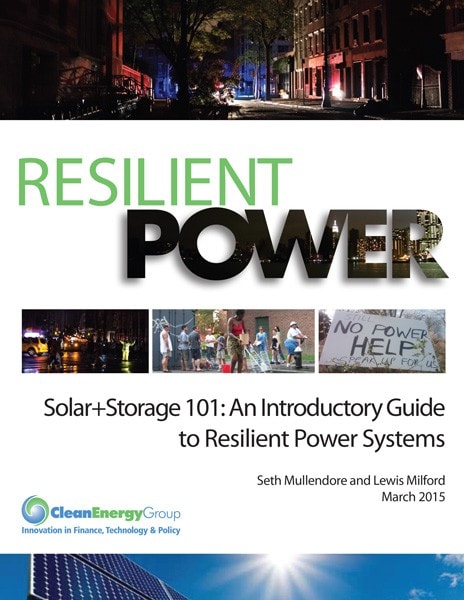March 11, 2015
Solar+Storage: What It Is, How It Works, and Why Your City Needs It
By Lewis Milford

But none of that will happen until people understand how this new technology hybrid works in practice. Toward that end, Clean Energy Group has written a new paper, Solar + Storage 101: An Introductory Guide to Resilient Solar Power Systems.
This is another in an ongoing series of reports produced by CEG’s Resilient Power Project. Its purpose is to provide a basic technical background and understanding of solar+storage systems. It is meant as a starting point for project developers, building owners, facility managers, and state and municipal planners to become familiar with solar+storage technologies, how they work, and what’s involved in getting a new project off the ground.
The guide first explores how a solar+storage system generally works and the basic layout of system configurations. It then takes a closer look at the components involved and necessary considerations for grid interconnection. The guide includes a checklist for cities or developers to assess whether solar+storage systems make sense for their buildings. The checklist helps a building owner look at the facility’s utility bill, critical loads and solar needs, and how installing a solar+storage system might help to protect the building’s occupants.
There is a growing need for this technology combination all over the country. Whether wildfires in the West, hurricanes in the East, ice storms in the North, tornadoes in the Plains and Midwest, or severe storms and flooding across the country, extreme weather is causing more numerous and costly power outages with each passing year.
This troubling reality has led federal, state, and local governments, as well as many business owners and facility managers, to the realization that there is a dire need for a more resilient, distributed approach to the current centralized U.S. power system.
Many organizations are beginning to explore the benefits of self-generation and more robust solutions for emergency backup power. Instead of relying solely on a centralized delivery system, where large, remote power plants are responsible for powering many thousands of customers and electricity delivery can be knocked offline by no more than a downed tree branch or unfortunate squirrel, individuals and organizations are beginning to take control of their own energy future.
The combination of solar photovoltaics (PV) with battery storage (solar+storage) is poised to play a pivotal role in this shift towards energy empowerment and the ongoing transition to more distributed and resilient power systems.
Historically, diesel-powered generators have been considered the standard for supplying emergency power in the event of power outages. Unfortunately, this dependence on diesel generators has left many in the dark when power is needed most.
Because backup generators sit idle most of the time, inadequate maintenance and testing often lead to failure when disaster strikes. And, unlike renewable energy sources, the power provided by diesel generators is typically limited by the amount of fuel that can be stored on-site. This is especially true during extreme weather events, when obtaining additional fuel may be extremely difficult or impossible due to widespread lack of power and limited resource availability. Because of this, even if diesel generators do work properly in an emergency, they may become useless during an extended power outage.
With steadily dropping costs in both solar and energy storage technologies, solar+storage has emerged as an economically viable and more reliable choice for emergency power. Not only do solar+storage systems have the ability to provide power indefinitely when the grid is unavailable, they can also cut costs and generate revenue during the 99.9% of the time when the grid is functioning normally. In many cases, these savings and revenue streams can drastically reduce the payback period of an energy storage system.
While solar+storage may not be the perfect solution for every resilient power project, its versatility and scalability make it ideal for many facilities, especially those located in urban and residential environments where space may be at a premium. A number of facilities that provide crucial services in times of emergency are good candidates for solar+storage; the list includes schools, community centers, assisted living facilities, and multifamily housing units.
These buildings often have relatively modest critical loads that are well-suited for the technology. The needs of more advanced projects, such as business complexes and microgrids, can also be met by large-scale solar+storage applications.
Clean Energy Group has also released a companion report, What Cities Should Do: A Guide to Resilient Power Planning, which provides a series of guidelines and best practices for cities and towns preparing to deal with the impacts of severe weather events. For more information on these reports, and for other resilient power resources, please visit www.resilient-power.org.














